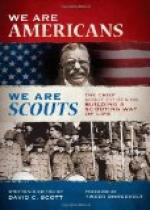After traveling up the Arkansas river some distance, above what is known as Big Bend, we struck the Buffalo Country, and I presume it was a week that we were never out of the sight of Buffalos. I remember we camped on the bank of the river just above Pawne Rock that night; the next morning we were up early and had our breakfast, as we calculated to make a big drive that day. Carson had been telling us how many days it would take us to make Bent’s Fort, and we wanted to get there before the Fourth of July. Just as we had got our animals packed and every thing in readiness to start, a herd of Buffalo commenced crossing the river about a half a mile above our camp. The reader will understand that the Buffalo always cross the river where it is shallow, their instinct teaching them that where the water is shallow, there is a rock bottom, and in crossing these places they avoid quicksand. This was the only crossing in fifteen miles up or down the river. We did not get to move for twenty-four hours. It seems unreasonable to tell the number of Buffalo that crossed the river in those twenty-four hours. After crossing the river a half a mile at the north of the ford, they struck the foot hill; and one could see nothing but a moving, black mass, as far as the eye could see.
I do not remember how long we were going from there to Bent’s Fort, but we got there on the second of July, 1847, and every white man that was within three hundred miles was there, which were just sixteen. At this present time, I presume there are two or three hundred thousand within the same distance from Bent’s Fort, and that is only fifty-eight years ago! In view of the great change that has taken place in the last half century, what will the next half century bring? The reader must remember that the increase must be three to one to what it was at that time.
After staying at Bent’s Fort eight days we pulled out for “Taos,” Carson’s home. He remained at Taos, which is in New Mexico, until early in the fall, about the first of October, which is early autumn in New Mexico; then we started for our trapping ground, which was on the head of the Arkansas river, where Beaver was as numerous as rats are around a wharf.
We were very successful that winter in trapping. It was all new to me, I had never seen a Beaver, or a Beaver trap. Deer, Elk, and Bison, which is a species of Buffalo, was as plentiful in that country at that time as cattle is now on the ranch. I really believe that I have seen more deer in one day than there is in the whole State of Colorado at the present time.
In the autumn, just before the snow commences to fall, the deer leave the high mountains, and seek the valleys, and also the Elk and Bison; no game stays in the high mountains but the Mountain Sheep, and he is very peculiar in his habits. He invariably follows the bluffs of streams. In winter and summer, his food is mostly moss, which he picks from the rocks; he eats but very little grass. But there is no better meat than the mountain sheep. In the fall, the spring lambs will weigh from seventy-five to a hundred pounds, and are very fat and as tender as a chicken; but this species of game is almost extinct in the United States; I have not killed one in ten years.




